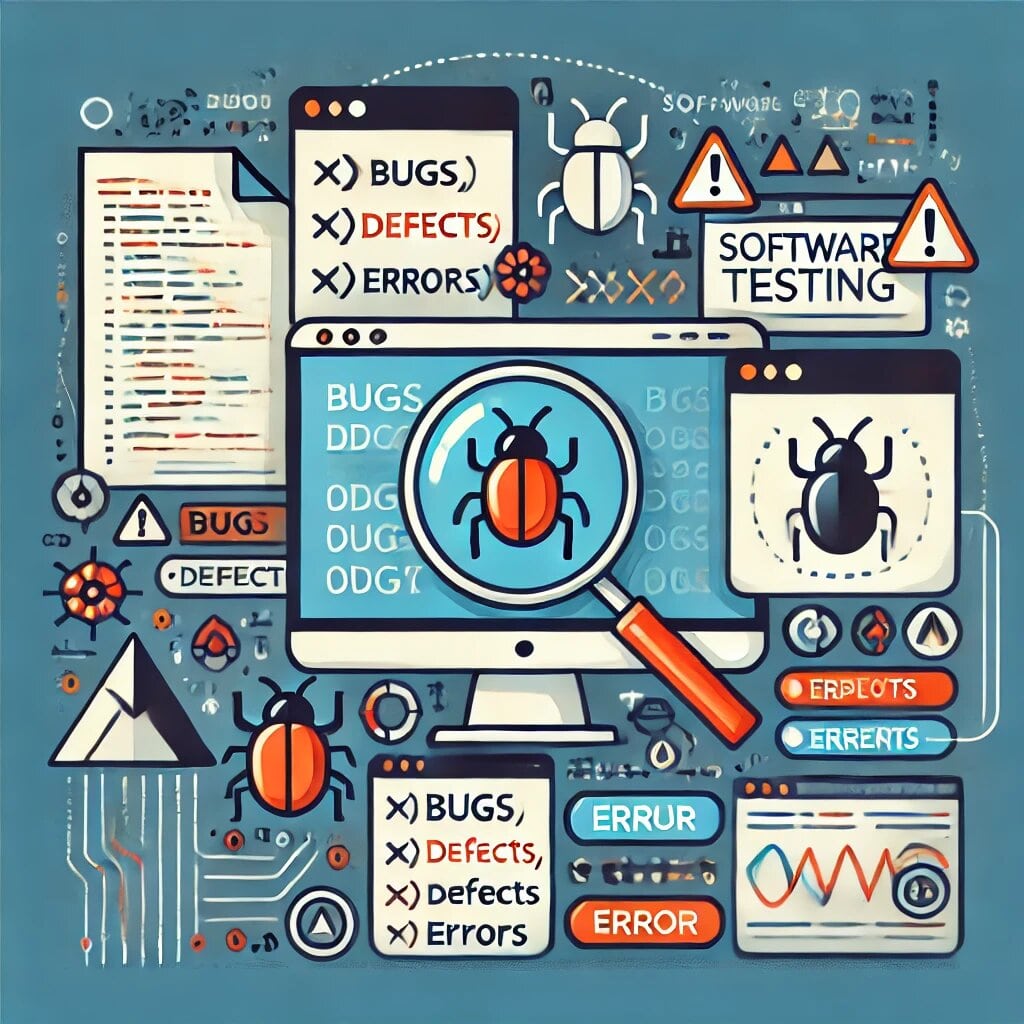Software development is a complex process, and even the most meticulously crafted code is prone to problems. These issues can take various forms, and terms like “bugs,” “defects,” and “errors” are often used interchangeably by both developers and testers. However, these terms have distinct meanings and play different roles in the broader software testing process.
Understanding these differences is essential for anyone involved in software development, from testers and developers to project managers and clients. In this article, we’ll provide a comprehensive guide to bugs, defects, and errors, helping beginners grasp these core concepts and see how they fit into the overarching software testing lifecycle.
What is Software Testing?
Software Testing is a critical phase of the development lifecycle, designed to identify issues in a program before it goes live. The process ensures that software meets the required standards of functionality, security, and performance. Testing encompasses multiple activities, including the identification of bugs, defects, and errors, which ensures that a product is delivered with minimal issues.
While testing is crucial for quality assurance, understanding the distinctions between bugs, defects, and errors can help teams better navigate and resolve issues as they arise during development.
Defining Bugs, Defects, and Errors
Let’s break down these terms in the context of software testing.
1. What is an Error?
An error in software development refers to a mistake made by a human during the coding or design phase. It could be a logical misstep or a misunderstanding of the requirements. Errors are often introduced due to miscommunication, a lack of understanding of the software’s functionality, or a simple oversight in the development process.
For example, if a developer mistakenly calculates a function to add two numbers instead of multiplying them, that is an error. Errors are typically the root cause of both bugs and defects.
Errors can occur during:
- Requirement gathering: Misunderstanding client needs.
- Design phase: Misinterpreting how a feature should work.
- Implementation/coding phase: Writing incorrect code.
2. What is a Bug?
A bug is a flaw in the software code that causes it to behave unexpectedly or produce incorrect results. Bugs are generally caused by coding errors and are often found during the testing phase of software development. They can vary in severity, from minor visual glitches to critical issues that crash the system or expose security vulnerabilities.
The term “bug” originated in the early days of computing when an actual moth caused an issue in a computer system. Since then, the term has been widely adopted to describe any problem in a software program.
For instance, a bug might cause an app to crash when a user clicks a specific button, or it might result in a webpage not displaying correctly across all browsers.
3. What is a Defect?
A defect is a deviation from the expected behavior of the software as outlined by its specifications or requirements. In other words, when the software does not meet the business or technical requirements, it is classified as a defect. This can result from incorrect coding, a misunderstanding of the requirements, or an oversight during the design phase.
While a bug refers to a specific problem in the code, a defect refers to a failure in meeting requirements. Bugs can lead to defects, but defects encompass a broader range of issues, including functional gaps or misalignment with the client’s expectations.
For example, if a shopping cart on an e-commerce website fails to update the total cost when an item is added, this would be considered a defect, especially if this functionality was explicitly stated in the requirements.
The Role of Bugs, Defects, and Errors in Software Testing
Understanding the roles of bugs, defects, and errors in software testing is crucial for ensuring high-quality software delivery. Let’s explore how these issues fit into the different testing phases:
1. Unit Testing
Unit testing is where individual components or functions of a software system are tested in isolation. Bugs and errors are most commonly identified during this phase. A unit test ensures that a specific function or feature works as intended without interfering with other parts of the code.
Errors introduced during coding or design are caught here, with the goal being to fix these before the code is integrated into the larger system.
2. Integration Testing
Integration testing focuses on ensuring that different components of the system work together seamlessly. Bugs often surface at this stage, as components interact and exchange data. If one module sends incorrect information to another due to a bug, integration testing will identify the issue.
Errors in communication between modules or services can also lead to defects if the system does not behave as specified.
3. System Testing
System testing is where the complete software is tested as a whole, evaluating the system’s overall functionality and performance. Defects often emerge during this phase when the entire application is tested against the original specifications or business requirements.
System testing can reveal both functional and non-functional defects. This is where discrepancies between the requirements and the actual implementation (defects) are highlighted, and where most user-facing bugs are identified.
4. Acceptance Testing
In acceptance testing, the software is evaluated against user or client requirements. Defects and bugs are reported by the client if the product does not function as expected. At this point, both functional defects (features not working as required) and usability bugs (UI/UX issues) may arise.
This phase aims to ensure that the final product meets the end-user’s needs and is ready for deployment.
The Importance of Classifying Issues Correctly
Correctly classifying software issues as bugs, defects, or errors can streamline the process of addressing and resolving them. Proper classification helps developers and testers understand the root cause of the problem and develop the appropriate fix. It also aids in prioritizing issues—critical defects, for example, may take precedence over minor bugs in a production release.
By clearly distinguishing between these terms, development teams can:
- Improve communication: Clear terminology helps ensure that developers, testers, and stakeholders are all on the same page regarding the nature of a problem.
- Optimize the testing process: Knowing whether an issue is a bug, defect, or error can streamline the process of resolving it and prevent reintroducing similar problems in future updates.
- Enhance product quality: A structured approach to identifying, classifying, and resolving issues contributes to higher product quality and greater user satisfaction.
Tools for Managing Bugs, Defects, and Errors
Modern software development relies heavily on tools to track and manage bugs, defects, and errors throughout the project lifecycle. Here are some widely used tools:
- Jira: One of the most popular tools for tracking bugs and defects. It offers robust project management capabilities and integrates well with various development environments.
- Bugzilla: A free, open-source bug tracking system. It allows teams to manage software issues effectively and is often used for larger, complex projects.
- GitHub Issues: For developers working on GitHub-hosted projects, GitHub Issues provides a built-in bug and defect tracking system, tightly integrated with the version control system.
- Trello: Although primarily a project management tool, Trello can be adapted for bug and defect tracking in smaller teams.
Final Thoughts
Understanding the differences between bugs, defects, and errors is essential for ensuring the success of any software project. While these terms may seem similar at first glance, each one represents a distinct aspect of the software testing and development process. By identifying and classifying these issues correctly, teams can streamline their workflows, enhance communication, and deliver higher-quality products.
If you’re looking for a more in-depth exploration of how bugs, defects, and errors impact the software development lifecycle.By leveraging the right tools and methodologies, development teams can address software problems more efficiently and ensure that their products meet the highest standards of functionality, usability, and performance.

